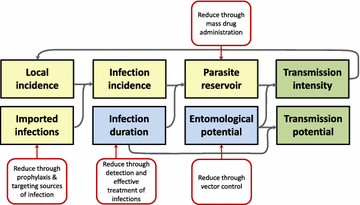Mapping multiple components of malaria risk for improved targeting of elimination interventions
- PMID: 29132357
- PMCID: PMC5683539
- DOI: 10.1186/s12936-017-2106-3
Mapping multiple components of malaria risk for improved targeting of elimination interventions
Abstract
There is a long history of considering the constituent components of malaria risk and the malaria transmission cycle via the use of mathematical models, yet strategic planning in endemic countries tends not to take full advantage of available disease intelligence to tailor interventions. National malaria programmes typically make operational decisions about where to implement vector control and surveillance activities based upon simple categorizations of annual parasite incidence. With technological advances, an enormous opportunity exists to better target specific malaria interventions to the places where they will have greatest impact by mapping and evaluating metrics related to a variety of risk components, each of which describes a different facet of the transmission cycle. Here, these components and their implications for operational decision-making are reviewed. For each component, related mappable malaria metrics are also described which may be measured and evaluated by malaria programmes seeking to better understand the determinants of malaria risk. Implementing tailored programmes based on knowledge of the heterogeneous distribution of the drivers of malaria transmission rather than only consideration of traditional metrics such as case incidence has the potential to result in substantial improvements in decision-making. As programmes improve their ability to prioritize their available tools to the places where evidence suggests they will be most effective, elimination aspirations may become increasingly feasible.
Keywords: Epidemiology; Health policy; Malaria; Operational planning; Risk mapping.
Figures

References
-
- Foege WH. House on fire: the fight to eradicate smallpox [Internet]. Berkeley; New York: University of California Press; Milbank Memorial Fund; 2011. http://public.eblib.com/choice/publicfullrecord.aspx?p=672392. Accessed 17 Aug 2015.
Publication types
MeSH terms
Grants and funding
LinkOut - more resources
Full Text Sources
Other Literature Sources
Medical
Research Materials

